Features
Read Christie 2019

Our final choice
To round off Read Christie 2019 in style, we've chosen The Pale Horse to fulfil the final prompt 'A late work'. Before the forthcoming BBC adaptation airs in 2020, we wanted to explore this fascinating and unusual novel, first published in 1961. Told from the protagonist's perspective, Mark Easterbrook gives us an insight into the period, village versus city life, and a case of suspected witchcraft.
What's it about?
Mark begins our story in the London borough of Chelsea, the 60s have begun, shepherding in unwelcome change, new trends and technology. Across town, a list of names is discovered in a dead victim’s shoe. Further afield, in the village of Much Deeping, a suspicious group of self-identified witches are linked to a series of deaths. Ariadne Oliver, Mark Easterbrook and indeed several officials take on the role of detective in an investigation into the eponymous Pale Horse.
It came to me suddenly that evil was, perhaps, necessarily always more impressive than good.
Why do we love it?
It’s unexpected! This is the first of Christie’s novels published in the 60s, and it reflects some of the fascinating cultural shifts which she’ll continue to cover throughout her next decade of writing. If you enjoyed October’s spooky selection, The Last Séance, you’ll love diving into our December read too. But don’t just take our word for it! Upon publication, The Guardian reviewed the book, stating:
The black magic theme is handled in a masterly and sinister fashion, and to give away what lay behind it would be unforgivable. This is a book which nobody (repeat, nobody) should miss.
The live book club
As we know your festive season is full to the brim with plans, deadlines, trips and to-dos, we won’t be hosting our live book club in December. You can update us on your final choice for #ReadChristie2019 using the hashtag on Instagram and Twitter. We've had such a great time sharing the Read Christie 2019 challenge. It has been wonderful to see your choices, and listen to your opinions, so we have some good news...
Reading in 2020
We're delighted to confirm that we will be running another Agatha Christie reading challenge in 2020. We'll be sharing details of next year's challenge later this month, so keep your eyes peeled! If you're a blogger who'd like to work with us on #readchristie2020, email us to introduce yourself and your channel.
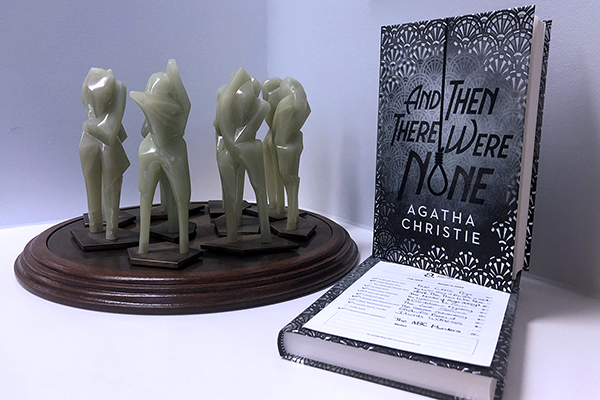
November
As we approach the end of the year, we’ve chosen to celebrate with the ‘your favourite Christie story’ prompt. In the team here at Agatha Christie Ltd, there are a whole host of favourite Christie stories (see our recommendations). So we settled on one that was loved by staff, the Queen of Crime, as well as by fans the world over – And Then There Were None. Celebrating its 80th birthday this month, the story was first published in the UK on November 6th 1939. As the bestselling mystery novel of all time, you may think it needs little introduction, however we’ve attempted to summarise this smart favourite for the benefit of new readers, as well as a reminder to those who want to revisit this classic work.
What’s it about?
Ten strangers, with seemingly little in common, are brought together on Soldier Island, off the coast of Devon. They have each taken up an invitation with the hope of personal gain, be it a job, a free holiday, or a chance to meet up with like-minded old companions. They arrive to find a very different proposition. Their hosts are nowhere to be found, and an eerie, anonymous gramophone message announces that they are all murderers. A poem in each bedroom tells of the death of ten little soldier boys, and as the guests begin to die in ways reminiscent of the rhyme, they suspect this is much more than a cruel practical joke.
There was nothing hidden in this house, nothing concealed. It had no atmosphere about it.
Somehow, that was the most frightening thing of all . . .
Why do we love it?
Once you’ve read it, it is easy to see why this is Christie’s bestselling novel. The author’s note, which appears before the story states how tricky it was to tell, and yet that “It was clear, straightforward, baffling, and yet had a perfectly reasonable explanation.” Upon publication, the New York Times review said “The whole thing is utterly impossible and utterly fascinating. It is the most baffling mystery Agatha Christie has ever written.” The set-up has gone on to inspire countless copycats, the story is fast-paced and the conclusion completely gripping. It is, simply put, a must-read!
The live book club
If you’re interested in chatting about this classic bestseller, we’ll be hosting an online book club discussion on Friday 29th November on Facebook from 1pm GMT. Join us throughout the afternoon to pose questions, share your thoughts and favourite things about the bestselling story. We’ll explore the extraordinary set-up of this story, the chilling atmosphere and the killer ending too. Can’t make it? Don’t worry. Share your reading progress with us using #ReadChristie2019 this month. Plus, tag us in your post for the chance to feature on our Instagram feed.
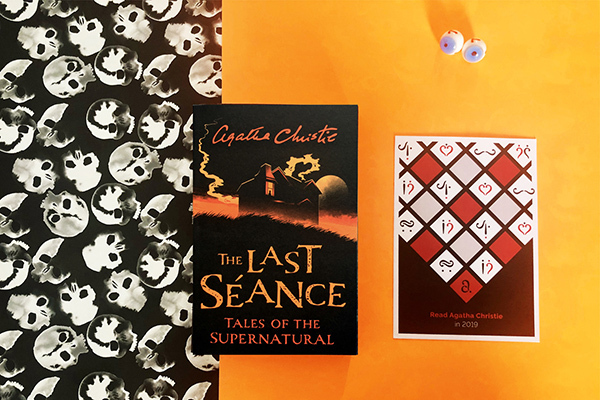
October
We’ve chosen the ‘seasonal story’ prompt and will be reading The Last Séance: Tales of the Supernatural. This is a new short story collection which brings together Christie’s spookiest stories – perfect for the arrival of autumn and Halloween! The book has now been released in the US and the UK (and is also due to be published in the Czech Republic, Hungary, Indonesia, Italy, Portugal, Russia and the Ukraine). If it’s not available in your area, don’t worry! You can find a list of all the stories here. They appear across a variety of Christie collections, primarily The Hound of Death, Miss Marple’s Final Cases, The Thirteen Problems (or The Tuesday Club Murders) and Witness for the Prosecution and Other Stories.
What’s it about?
Where do we start?! There’s a deadly conjuring which will surprise and scare you. An Egyptian curse killing off archaeologists one by one (until Poirot gets to the bottom of it, that is). A doll who appears out of nowhere, and can move at will. A psychic's mortal warning (which Miss Marple aims to discredit). A haunting radio speaking with a voice from beyond the grave. Throw in a dangerous mirage at a country house, and you’ve got a collection fit for Halloween. Starring two of Christie's famous sleuths, and a host of creepy characters, The Last Séance is a must-read.
Written in the dust were three letters, clearly visible, S.O.S. He was right, then. Something was wrong in this house.
Why do we love it?
The selected stories work so well together! The theme really shines (or should that be shrieks) throughout, and we’re spooked, surprised and entertained in equal measure. We can marvel at Christie's storytelling in both well-known mysteries, ‘Philomel Cottage’, and lesser-known gems – ‘The Wife of the Kenite’ has never been published in the US before. Defying convention might be part of the charm of these tales, but at their heart, these are just exceptionally good stories. Enjoy!
The live book club
This month we’re using Halloween as a good excuse to chat about all of Christie’s scariest stories! Join us on Thursday 31st of October for our most frightening book club ever. We’re thinking The Last Séance, Endless Night, Hallowe’en Party, The Hound of Death and The Thirteen Problems. We’ll be live from 4 – 6 pm (GMT) to chat across Facebook and Instagram. Don’t forget to share your reading progress with us using #ReadChristie2019 this month. Plus, tag us in your post for the chance to feature on our Instagram feed.

September
September has arrived, and we've chosen to read a Hercule Poirot story. For this prompt we've selected Five Little Pigs. The novel, which is among Agatha Christie's top ten bestsellers, was described in The Guardian as "a very pretty problem for the ingenious reader" (1943). Published in 1942, the book was originally named Murder in Retrospect in America. It is one of several titles Christie named after a traditional nursery rhyme in the UK.
What's it about?
Carla Lemarchant arrives at Poirot's quarters with a troubling family history. Her mother, Caroline Crale, was famed for killing her husband when she was a small child. Her father, Amyas Crale, was a famous painter, fond of affairs and absorbed by his art, and his widow was tried and found guilty of poisoning him. On her death bed she wrote a letter to her only daughter, Carla, proclaiming that she was innocent of the crime. Carla yearns for the truth, so that now, at 21, she may marry her fiancé. Poirot must track down five witnesses of varying fortunes, much like the pigs of the famed nursery rhyme, and decipher the truth about what happened over a decade ago, from their first-hand accounts.
This little piggy went to market,
This little piggy stayed home,
This little piggy had roast beef,
This little piggy had none,
And this little piggy cried "wee wee wee" all the way home.
Why do we love it?
With Five Little Pigs the reader is treated to a bestselling classic, but also an unconventional Christie. We open the first page to encounter a murder that occurred 16 years before. We are fed the story from multiple perspectives, helping us to understand the complexity of the case and yet providing us with ample details so that we could potentially solve it ourselves. Whilst this narrative arc might be something crime fiction fans are accustomed to nowadays, it was a bold, brave mystery to write in 1942, and it is told excellently by Christie, and of course, by Hercule Poirot! The house and garden where the murder took place is also closely based on the Greenway Estate.
The live book club
The ACL live book club returns this month, as we meet on Facebook to discuss the fantastic Five Little Pigs. We put it to the vote and asked fans when they'd like us to host it. We can confirm this will take place on Friday 27th September at 4pm BST/UTC. As always, you can keep us updated with your reading progress using #ReadChristie2019 on social media. You can also email generalenquiries@agathachristie.com using the subject heading 'Read Christie 2019'. Thanks for your continued enthusiasm for the challenge!

August
Inspired by Agatha Christie’s own travel to the West Indies, A Caribbean Mystery is a summer read we couldn’t wait to pick up. Published in 1964, this story is both a late work, and a story set abroad (we’ll be ticking off the latter this month). Christie would have been in her 70s when she wrote this story, and themes of age are prevalent throughout, making this a witty, yet thought-provoking read – it also acts as a reminder to be kinder to our elders!
What’s it about?
We join Miss Marple on her trip to the Caribbean, kindly organised by her nephew Raymond West. She is enjoying staying at the Golden Palm Hotel, on the island of St Honoré. The other guests include ornithologists, a Canon, a retired Major and a grumpy millionaire, some of whom consider their best days behind them. They’re well-looked after by the young Kendals, who have likely bitten off a little more than they can chew with this hotel. A peculiar conversation about a murderer stands out amidst Major Palgrave’s past recollections of Kenya and the Western Frontier, but he dies before Miss Marple can get to the bottom of what he was saying. In the West Indies too, she is underestimated by doctors and detectives alike, but her determination to get to the truth about the Major’s death means we can’t put our feet up for long. An injustice has been done, and we can be sure Jane Marple will get to the bottom of it.
Conversations are always dangerous, if you have something to hide.
Why do we love it?
Despite embracing the hotel’s ice cream sundaes, and indulging in a lot of sea air, Miss Marple does miss the Great British weather, as well as the home comforts of St. Mary Mead. Her need to find similarities in her exotic setting is one most readers will know, and can relate to. This book contains a healthy dose of escapism, but with the usual intrigue and musings we associate with Miss Marple’s village mysteries.
The live book club
Similar to last month, we won’t be hosting our live book club in August to allow holiday-makers to set off and enjoy their (hopefully more relaxed) reading moments. Once again, you can update us on your #ReadChristie2019 progress using the hashtag on Instagram and Twitter. Got something you’d like us to chat about on our channels? Simply email us with your suggestions. We’d love to hear from you.

July
Can you believe that we’re already half-way through 2019?! That means there are just six more prompts to choose from to complete our Agatha Christie reading challenge. This month we’re reading a Tommy and Tuppence story. We’ve chosen The Secret Adversary to kick-start our summer with a spot of adventure! Most recently adapted for television in 2015, Partners in Crime starred David Walliams and Jessica Raine as the lovable duo in a six-part series for the BBC.
What’s it about?
The Prologue begins on the sinking Lusitania in 1915, as some secret documents are handed to an unsuspecting woman who will be carried to safety. Intriguing! Yet skip forward to Chapter 1 and we join our pair at the close of World War I. Jobs are in short supply, and money is almost impossible to get hold of, so Tommy Beresford and Tuppence Cowley, childhood friends, form The Young Adventurers Ltd. Born out of a desire for money, the pair are catapulted into a dazzling yet dangerous world of Russian spies, trips to The Ritz, and life-threatening pursuits. All of this, before they've even printed their first advert for the business!
You’re such young things, both of you. I shouldn’t like anything to happen to you.’
‘It won’t,’ Tuppence assured him positively.
‘I’ll look after her, sir,’ said Tommy.
‘And I’ll look after you,’ retorted Tuppence, resenting the manly assertion.
Why do we love it?
Christie’s second novel, and the first to star Tommy and Tuppence, showcases the author’s imagination and sense of fun. This 1922 story is dedicated to readers ‘in the hope that they may experience at second-hand the delights and dangers of adventure.’ This story delivers, I can assure you. The two protagonists work together, in a manner that isn't common to Christie's most well-known sleuths. A suspenseful narrative, with real heart, we recommend meeting this pair at the beginning of their careers.
The live book club
Summer is a busy time, what with school holidays, planned trips and plenty of relaxed reading, so we won’t be hosting our usual live book club this month. Instead, we’ll be encouraging you to update us on your #ReadChristie2019 progress using the hashtag on Instagram and Twitter. Got something you’d like us to chat about on our channels? Simply email us with your suggestions. We’d love to hear from you. We're also delighted to welcome #JeLisAgathaChristie, the french reading challenge established by Livre de Poche.
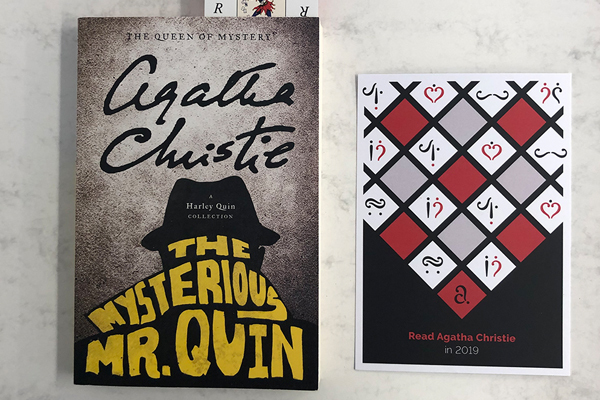
June
This month, we've chosen to read a short story collection. Agatha Christie was a prolific short story writer, and it is very hard to choose between the collections. We decided on The Mysterious Mr Quin as it shows a different dimension to Christie's writing, and we love the unexpected themes which are threaded throughout the book. So, if you've never met Mr Satterthwaite and his unusual friend Mr Harley Quin, we highly recommend reading along with us this month. You won't be disappointed.
Mr Quin, I consider, is an epicure's taste.
What's it about?
The stories all star two protagonists: Mr Satterthwaite, now in his 60s, is a sociable member of high society, who prefers to be an onlooker to others’ dramas. Mr Harley Quin is an enigmatic and mysterious character, who turns up in the least likely places, to probe the details of a cold case or aid the understanding of a romantic tryst, and guides Mr Satterthwaite towards the truth. Though neither man is a detective, they work together to effectively unpick troubling mysteries, and seemingly impossible situations that have happened to people. Mr Quin's omniscience has led readers to question his physical existence, and supernatural elements are woven effectively throughout the collection.
Why do we love it?
This sleuthing pair aren't as well-known to readers, and that makes for a more surprising read. Their developing relationship is charming, yet purposeful, and it is fun to try and work out the stories' puzzles, and come up with possible solutions with Mr Satterthwaite. Christie took inspiration from the commedia dell'arte for her mysterious protagonist, an approach that we only see in this story collection. These stories too are distinct, and all the better for that. Share your thoughts about these stories and their characters, and read along with us using #readchristie2019 on social media.
The live book club
We will be hosting our live book club chat about The Mysterious Mr Quin on Friday 28th June at 4pm (BST) on Facebook. We hope you can join us then to discuss this compelling collection then. If you'd like to join in on Instagram or Twitter, let us know via email as we're keen to make sure as many fans as possible can be a part of our new initiative.

May
This month, we’ve chosen to read a country house murder, Dumb Witness. The dedication, made out to Christie’s pet wire fox terrier, reads ‘To dear Peter, most faithful of friends and dearest of companions, a dog in a thousand’. A pet dog named Bob, features prominently in the story, and is one of the most buoyant characters at the country house where the death of Emily Arundell takes place.
What’s it about?
Miss Emily Arundell of Littlegreen House in Market Basing is an unmarried woman in her 70s. She lives with her companion Miss Lawson, who she treats with contempt and her dog Bob who she reveres. She has a host of nieces and nephews, who seem more devoted to her promise of inheritance, than to their aunt.
She was Miss Arundell of Littlegreen House. She was ‘one of our oldest customers’. She was ‘one of the old school. Not many about like her nowadays’.
As the family visitors descend on the country house for Easter weekend, requests for money are made and Miss Arundell suffers a near fatal fall. Suspicious of the circumstances, and perhaps determined not to blame dear Bob, the protagonist writes to Hercule Poirot… but the letter turns up months later. Poirot is determined to investigate the cryptic correspondence he has received, but the mistress who sent it died on May 1st.
Why do we love it?
Did we mention the dog? Bob’s character is a truly charming addition to this crime story, and Christie imbues him with a cheeky sense of character. Pets aside, the set up of Dumb Witness is fascinating as we are given full details before the death and afterwards, but there’s a big gap in the reader’s knowledge. That is, until Poirot employs a few deceptions to gain confidences in the village. Captain Hastings’ righteous indignation is also excellent. Share your thoughts about the novel, and read along with us using #readchristie2019 on Twitter and Instagram.
The live book club
We will be hosting our live book club chat about Dumb Witness on Friday 31st May at 4pm (BST). We hope you can join us on Facebook to discuss this story. Thanks to everyone who joined us for April’s chat about The Murder of Roger Ackroyd. We had a great time!
April

Welcome back to Read Christie 2019. This month’s book choice is an early story! We’ve decided on The Murder of Roger Ackroyd. Join us for a classic crime story that always gets readers talking.
What’s it about?
The story begins with the death of a Mrs Ferrars in the village of King's Abbot. The local doctor and our narrator, Dr. James Sheppard is called to the house of Mrs Ferrars, but he is too late to save her. His sister, Caroline Sheppard, is the village gossipmonger, and quickly speculates on a motive for suicide.
Among the village inhabitants are wealthy widower, and suspected lover of Mrs Ferrars, Roger Ackroyd, and retired Belgian detective, Hercule Poirot. The death unsettles Ackroyd, who immediately consults with the Doctor, before the eponymous murder is committed. Now there are two suspicious deaths, rumours of blackmail, and a house full of riled servants. Roger Ackroyd's sister-in-law is angered by the will, his adopted son Captain Ralph Paton has vanished and Ralph's fiancée Flora Ackroyd (Roger's niece) is helpless to defend his honour... Are you keeping up?
Dr Sheppard must assist Poirot, to find out the means, motive and opportunity for the murder, and save innocent lives. But can they sort fact from fiction, in a village alive with speculation? And can Caroline Sheppard's loose tongue be put to good use for once?
Caroline can do any amount of finding out by sitting placidly at home... When she goes out, it is not to gather in information, but to spread it. At that, too, she is amazingly expert.
Why do we love it?
There are too many reasons to list here. This is one of Poirot's most memorable cases, and a story which has encouraged hundreds of thousands of readers to discover Christie. It is a locked room mystery, it doesn't shy away from including romance, and has an unforgettable ending. Share your thoughts about the novel, and read along with us using #readchristie2019 on Twitter and Instagram.
The live book club
We will be hosting our live book club chat about The Murder of Roger Ackroyd on Facebook, on Tuesday 30th April at 4pm (BST). We hope you can join us to discuss the novel. Last month, we launched this initiative, with a live chat about The Mirror Crack'd from Side to Side. Thanks to everyone who joined us to share their thoughts of the story.
March
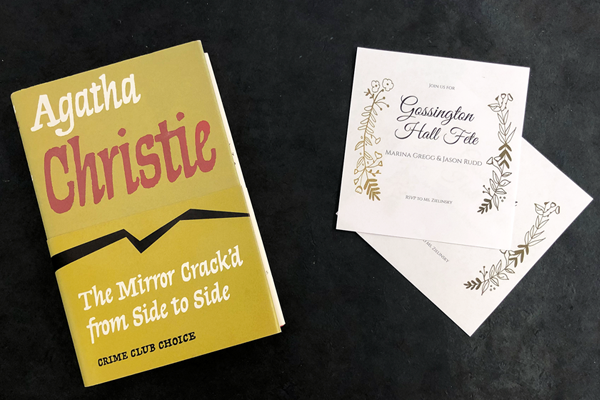
Hello and welcome to Read Christie 2019, the official Agatha Christie reading challenge. Don’t forget to download your reading list, so you can share your progress with us! We’ll be checking #ReadChristie2019 regularly, and sharing some of our favourites on Instagram and Twitter. So, on to our March choice: A Miss Marple story!
To celebrate the arrival of the European stage premiere of The Mirror Crack’d, we’ve chosen to read The Mirror Crack’d from Side to Side this month. The eighth novel to star Miss Marple, this book was written in 1962, and the sleuth is showing her age. The story challenges Miss Marple's skills of deduction, as she can't be on the scene to pick up clues about the case.
What’s it about?
St Mary Mead’s latest arrival to the village, American film star, Marina Gregg is causing a stir amongst the gossips. Miss Marple is unable to attend the charity fête the Hollywood starlet hosts at her new residence, Gossington Hall, so doesn’t witness the untimely death of guest, local woman Heather Badcock.
She was a nice woman who talked too much, but nobody gets murdered for that - unless of course they give away secret.
Heather Badcock, a do-gooder, is from The Development. Why would anyone want to murder her? A spiked cocktail leads Marple, and Chief-Inspector Craddock to suspect that Marina was the intended culprit... But the list of suspects for Marina's murder is a little longer. Did the Butler, Giuseppe, poison the cocktail? Isn't Jason Rudd, Marina's latest husband, a little too protective? And does his secretary, even like the mistress of the house?
Rumours abound, and Miss Marple must stay abreast of them from home, as she recuperates after an injury. Cherry Baker - the cleaner, and imposing household help, Miss Knight, have plenty of details to help their employer decipher the facts. Meanwhile Craddock investigates poison pen letters, as further startling murders are carried out at Gossington Hall.
Why do we love it?
Inspired by tragic events in actress Gene Tierney’s life, Christie demonstrates her ability to use real-life goings-on to create compelling fiction. This work has been adapted for the small screen several times, as well as for radio, and is now gracing the stage. This showcases the strength and versatility of the story. The cult of celebrity, village gossip and snobbery collide in this dazzling book. Miss Marple is as astute and entertaining as ever, refusing to let her age get the better of her.
We can’t wait to hear what you think!
February

Welcome back to Read Christie 2019, the Agatha Christie reading challenge. To join us, subscribe to the Agatha Christie newsletter and download our 2019 reading list. You can share your choices for the year using #ReadChristie2019. For further details about the challenge, see below.
This month, we’re getting stuck into a less conventional Christie. In fact, when this book was published in 1933, it wasn’t an Agatha Christie story at all! That’s right, we’re reading Mary Westmacott’s Giant’s Bread this month. As we traditionally celebrate love in February, we thought it was the perfect time to choose one of her stories about passion – you won’t be disappointed.
To be in love with Jane might be a whole-time job.
What’s it about?
A young child called Vernon, who grows up at the country manor of Abbots Puissants. Learning to navigate an adult-centric world, we share Vernon's passions and fears (the piano - aka The Beast), uncover his father's indiscretions and meet his childhood friends, Sebastian and Joe. Divided into five parts, the story follows these three and their love interests, giving the reader insight into each character as they attempt to determine their correct course in life, with ample advice from friends and family to consider.
Sebastian, a passionate lover of music, is determined to encourage Vernon's musical talents. Vernon, pre-occupied initially with thoughts of marriage, is latterly consumed by his art, as he attempts to redefine the operatic form. Joe, who decided from a young age not to 'lose her head over a man', disregards social convention and seeks a match based on love.
Will questions of money, inheritance and honour thwart their youthful ambitions? Can their friendships withstand the strain?
Why do we love it?
A story of ambition, music, passion and sacrifice, this captivating narrative grows as the lives of the subjects do. Unlike anything Christie's crime readers will have seen before, this is the perfect introduction to her Westmacott novels. Expect feuding families, marriages of (in)convenience, and a healthy dose of artistic temperaments.
January
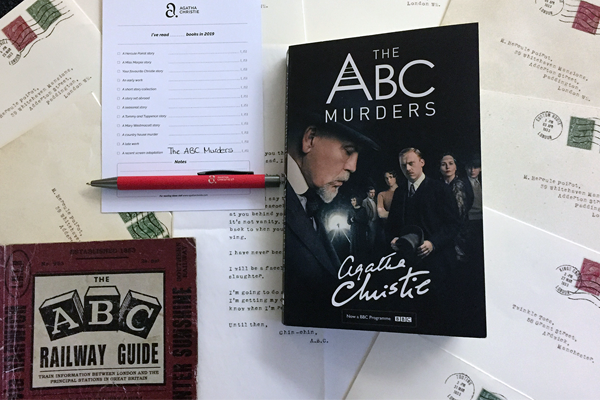
Welcome to our brand new reading challenge: Read Christie 2019.
We can’t wait to read along with you this year, and have provided a brand new checklist to help prompt your Christie story exploration. The themes include ‘A Miss Marple story’, ‘A late work’, ‘A seasonal story’ and plenty more. You can choose to read the 12 stories we select, mix and match with some of ours, or select 12 of your very own. The 12 can be complete novels or individual short stories, and can include any audio adaptations you listen to too.
To download your checklist, simply click the Download button at the bottom of this post. The postcard will allow you to track your progress, the titles you choose, and to rate each one out of five. Already a subscriber? There’s a link to download the list at the bottom of this article. Don’t forget to share your lists, progress and thoughts with us on social media, using #ReadChristie2019.
So, on to our first choice…
After the UK premiere got everyone talking this Christmas, we thought it was the only choice to kick off our 2019 reading challenge. So here it is – we’re reading a recent screen adaption, The ABC Murders this month.
What’s it about?
The ABC Murders begins with a jibing letter to Hercule Poirot, signed A B C.“You fancy yourself, don’t you, at solving mysteries that are too difficult for our poor thick-headed British police?”
As A B C’s first victim, Mrs Alice Ascher is found dead in her tobacconist at Andover, the detective claims that ‘This is the beginning’, and he’s right. As the killer taunts Poirot by post, they continue to murder victims according to the letters of the alphabet, leaving an A B C railway guide at the scene of the crime – a seemingly impenetrable clue.
Searching for ways to link the murders, Poirot must travel the country with help from his companion, Captain Hastings. Working to prevent the murderer reaching Z, are a host of Scotland Yard officials, including Inspector Crome, who is keen to look at the psychology of the perpetrator. The letters could provide ample insight into the killer’s motives, but can they afford to wait for another one…
Initially told by Hastings, the story is occasionally interrupted by the narrative of a Mr Alexander Bonaparte Cust, a travelling salesman who suffers from black-outs and memory loss.
Why do we love it?
Fast-paced and expansive, this story stands out in the Christie canon. Reading (or re-reading) the book reminds us that Agatha Christie didn’t adhere to convention, or to the genre known as cosy crime. A fascinating read.
Find out more about The ABC Murders (TV Show)


 UK
UK 